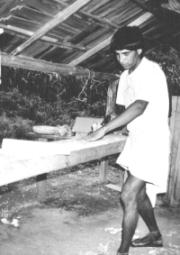
Patrocinio is a Tarahumara Indian. He is also a successful man. He owns two houses—a winter house located in the bottom of the canyon, only a two-and-a-half hour hike from the town of Batopilas, and a summer house at the top of the canyon, a six-hour hike from the village of Samachique.
Both of his houses are typically Tarahumara. They are made up of a combination of loosely fashioned together materials, mostly hand-hewn timbers, adobe, and piled up stones, with a wood shake roof. They have one room for eating and sleeping and one storage room. Outside the house are a corn crib and a work shed where Patrocinio crafts his violins. Furnishings are simple; the family sleeps on straw mats and cooking is done over an open fire.
Like most Tarahumara, Patrocinio is a subsistence farmer. He feeds his family by growing corn, beans and squash. During the slow season he has time to devote to his true love—making his violins. He sells the violins to other Tarahumara, who highly prize them, and to the Mission Store in Creel, where they are resold to the tourists. The sales provide him with cash to purchase the store-bought items that the family needs, such as coffee, lard, salt, sugar, matches and cotton cloth.
Patrocinio's wife, Aurelia, is a homemaker. She cooks the meals, washes the clothes, cleans the house and tends the children. She also makes and sells baskets to supplement the family income.
His three daughters, Marca, Felicia, and Paola, ages 5, 4, and 2, also have their jobs. Six times a day they hike the 500 yards to the gorge with buckets on their heads to fetch water from the stream; often the 2-year old is carried in a shawl on her older sisters back.
The girls are also responsible for keeping the goats out of the cornfields. They are experts at throwing rocks which land alongside any goat who gets too close.
The goats are very important to the feeding of the family—but not as a source of meat. At night they are kept in a small portable log corral. The corral is set up over a dormant field and every few days is taken apart and moved along the rows. In this way the fields are fertilized and are ready to be planted for next years crop.
Around 1300 miles northwest of Patrocinio's home is the home of California Native guide Doug Stewart. Doug is a friend of Patrocinio's.
The two men met during the Kórima food program which Doug and his partner, California Native guide Lynn Reinecke, instituted in the winter of 1983 to help the Indians survive the previous years crop failure (California Native Newsletter, Summer 1993). Since both Doug and Patrocinio are craftsmen—Doug specializing in woodworking and ceramics—they became good friends. Doug now visits Patrocinio and his family several times a year.
When Doug first met Patrocinio, Patrocinio's violin making tools consisted of three cheap Mexican pocket knives, a hacksaw blade with a rag wrapped around it, an awl made from an old nail, an old spike filed into a chisel, broken glass used for scraping, a bent knife made from a car spring, and rope and pieces of wood for clamps. With these makeshift tools Patrocinio produced six violins a year.
After his first visit, Doug consulted with American violin makers and studied the techniques and tools needed to produce hand crafted violins. On his subsequent visits Doug brought Patrocinio gifts of quality violin making tools: high carbon steel knives, chisels, gouges, saws, awls, twist drills and planes; violin clamps, a diamond sharpening stone, sand paper and varathane varnish.
With the new tools, the quality of Patrocinio's violins as well as the quantity he can produce have greatly improved. He now makes twice as many violins in a year and the extra revenue benefits his family.
Patrocinio has given Doug some of his finest violins—a gift, which to Doug, cannot be valued in terms of money—a gift of friendship and mutual appreciation between two people of widely different cultures.
Click Here for information on our Copper Canyon Tours.


